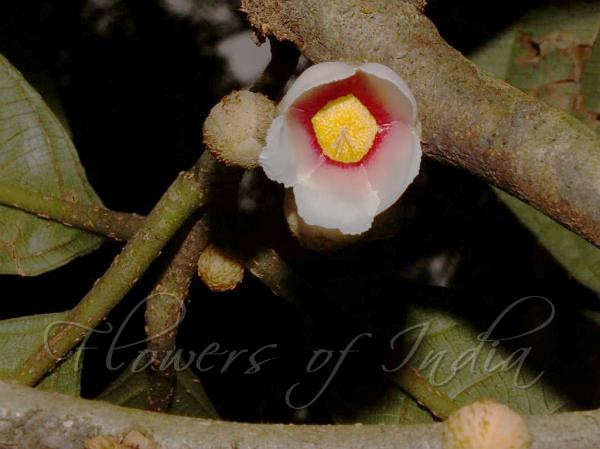|
| Parbatia Sengunia |
|

|

| File size | 168124 |
| Original date | 6/22/17 10:22 AM |
| Resolution | 1024 x 768 |
| Flash | Flash fired |
| Focal length | 21.2mm |
| Exposure time | 1/4000s |
| Aperture | 11.0 |
| Focus Distance | 0.0m |
| Metering Mode | Spot |
| Camera make | FUJIFILM |
| Camera model | FinePix HS35EXR |
| Sensor type | OneChipColorArea |
|
|
|
|
Photo: |
Botanical name: Saurauia armata Family: Actinidiaceae (Kiwifruit family)
Synonyms: Saurauia cerea, Saurauia dillenioides
Synonyms: Saurauia cerea, Saurauia dillenioides
Parbatia Sengunia is a small tree, 5-7 m high with
climbing branches. Young stems and branches have sharp pointed stiff
hairs. Leaves are 20-28 x 10-14 cm, obovate, abruptly short tapering at
tip, pointed or rounded at base, remotely sawtoothed along margin with
pointed stiff hairs, papery, hairless above, scattered stiff hairy on
lateral veins beneath. Lateral veins are 18-21 on either side of
midrib; leaf-stalks 1-2.1 cm long, stout. Flowers are borne in
leaf-axils, solitary, in clusters. Sepals are elliptic or round,
woolly, with sharp pointed scales outside. Petals are white, with
reddish base, round-obovate, hairless. Stamens are numerous, minute,
0.1-0.2 cm long. Carpels are spherical, ovary densely hairy; styles 5,
fused, hairy at base. Fruits is ovoid, densely hairy. The ripe fruits
are eaten. Wood is used for construction of houses. Parbatia Sengunia
grows in tropical and subtropical mixed forests along riverside, in
Arunachal Pradesh, Assam and Meghalaya, also in Bhutan, China, Nepal
and Myanmar. FIowering: March-August.
Medicinal uses: Sweet crushed young twigs and
leaves are applied on cuts and wounds to stop bleeding and for healing.
Sweet crushed young twigs and
leaves are applied on cuts and wounds to stop bleeding and for healing.
Medicinal uses:
 Sweet crushed young twigs and
leaves are applied on cuts and wounds to stop bleeding and for healing.
Sweet crushed young twigs and
leaves are applied on cuts and wounds to stop bleeding and for healing.
| Identification credit: Nidhan Singh | Photographed in Biswanath Chariali distt, Assam. |
• Is this flower misidentified? If yes,